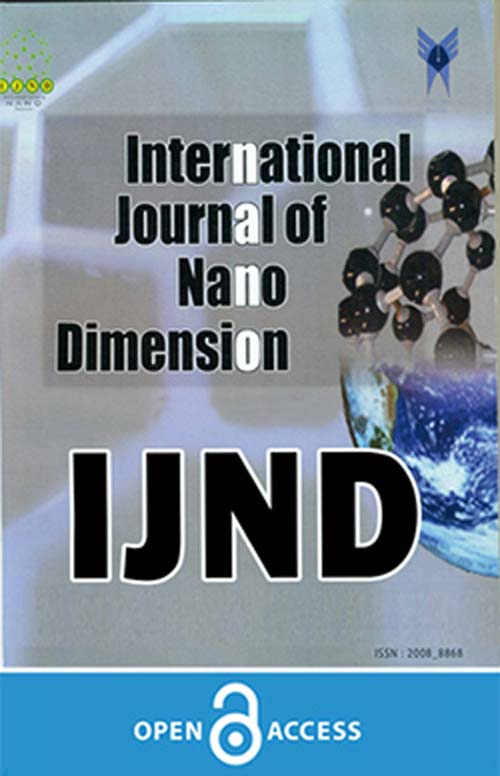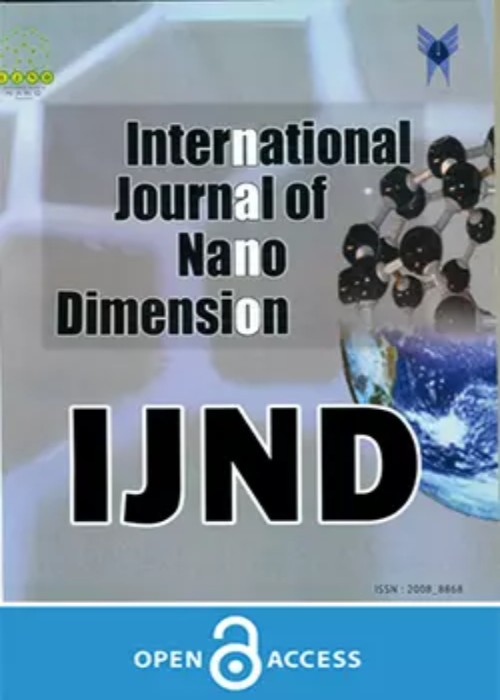فهرست مطالب

International Journal of Nano Dimension
Volume:13 Issue: 2, Spring 2022
- تاریخ انتشار: 1400/12/03
- تعداد عناوین: 10
-
-
Pages 144-154A simple and green method based on chemical fragmentation of wood charcoal is used to produce carbon quantum dots (CQDs). These CQDs are used to form a nanocomposite with synthesized titanium dioxide nanoparticles (TiO2/CQDs). The X-ray diffraction (XRD) analysis of this TiO2/CQDs nanocomposite has revealed that the presence of CQDs in these TiO2/CQDs does not affect the TiO2 NPs crystalline structure; while the characterization using scanning electron microscopy (SEM) analysis shows a porous structure of TiO2 NPs and TiO2/CQDs resulting from the aggregation of nanoparticles with a mean size of around 25 nm and 30 nm for TiO2 NPs and TiO2/CQDs, respectively. Furthermore, a transmission electron microscopy (TEM) analysis displays particle size around 4 nm for CQDs. Besides, the reflectance study in the visible range shows that the presence of CQDs reduces the reflection of sunlight by TiO2 NPs in TiO2/CQDs nanocomposite. Moreover, compared to TiO2 NPs, TiO2/CQDs have a higher rate for methylene blue (MB) photocatalytic degradation. Indeed, an efficiency of up to 100% within ten minutes of sun exposure for the degradation of 7.5 mg/L MB can be achieved using TiO2/CQDs in opposition to thirty minutes using TiO2NPs under the same conditions. This efficiency is obviously due to the reduction of the reflective properties of TiO2 NPs in the visible range by the presence of CQDs in the TiO2/CQDs nanocomposite. These results suggest that TiO2/CQDs could be used as heterogeneous photocatalyst for the degradation of similar compounds in water bodies under solar irradiation.Keywords: Carbon Quantum Dots (CQDs), Fluorescent CQDs, Methylene Blue Photocatalytic Degradation, Reduction of TiO2 Reflective Property, TiO2 Nanoparticle Synthesis
-
Pages 155-167The present work reports the Hirshfeld surface analysis and photocatalytic performance of NiFe2O4 nanomaterial. Hirshfeld surface analysis was performed to understand the interaction properties of the NiFe2O4 compound. The active sites including π-π interactions are studied by the analysis. The Hirshfeld data showed that the two wings in the O…O and O…Ni diagrams are created by short contacts of O…O, and O…Ni which causes O―O…π and O―Ni…. π interactions. The interactions cover the surfaces with values of 8.8% and 9.4%, respectively. Nanostructured NiFe2O4 powder was used as a photocatalyst to degrade Malachite Green (MG) waste water pollutant dye under visible light irradiation. The optimized conditions for the degradation of a 100 mL of 80 ppm MG aqueous solution are 0.03 mL H2O2, 0.038 g catalyst, and 45 min reaction time. The degradation yield at the optimized conditions under visible light irradiation was 95 %. The light source was a white color fluorescent lamp with the 40 W power and light intensity of 1.34 W/m2 measured by a digital lux meter.Keywords: Dye degradation, Hirshfeld Surface Analysis, Malachite green, nanophotocatalyst, nickel ferrite
-
Pages 168-178In the last decade, the bio-assisted synthesis of nanoparticles has been significantly exploited seeing the shortfall of chemical synthesis and urgent need to find the substitution. The chemical synthesis of nanoparticles is a rapid process, which might be appealing in various frontiers but has got some serious issues to take care of. In pursuit of finding a process that is cleaner, non-toxic, eco-friendly, low cost, and renewable, natured introduces us to the prospect of biosynthesis. In our study, we have successfully prepared bimetallic nanoparticles through a bio-assisted route. We have formed (Ag-Zn) silver doped zinc oxide nanoparticles with the help of an aqueous leaf extract of Azadirachta indica. Ag-Zn nanoparticles were further characterized by FTIR, P-XRD, SEM-EDX methods. The data obtained from X-ray diffraction has shown the peaks of silver doped zinc at 2θ value 38.1o thereby telling particle size is approx. 12.53 nm size as calculated by Scherrer’s equation. FTIR analysis gave characteristic peaks of functional groups. SEM-EDX confirmed successful doping and grain size of the particle. The study has further characterized the anti-microbial activities of the Ag-Zn BMNPs (Bi-metallic nanopartilces) with the help of the Kirby-Bauer method showing maximum inhibition of Streptococcus aureus species. The result of the study can be advantageous to develop an understanding of the development of nano-based medicine.Keywords: Antimicrobial, Azadirachta indica, Bio-Assisted, nanoparticles, nanotechnology
-
Pages 179-196
Full adder cells are the major fundamental elements of larger arithmetic circuits, which are mostly located along the critical path of circuits. Therefore, the design of low-power and high-speed full adder cells is critical. In this paper, there are two new inexact full adder cells proposed based on Carbon Nanotube Field Effect Transistor (CNFET) technology. Using the HSPICE simulator by applying the 32 nm Stanford model, extensive simulations are performed at the transistor level. Different supply voltages, output loads, and ambient temperatures are involved in the operation of the cells. In addition, by applying Monte Carlo transient analysis, the effects of diameter variations of carbon nanotubes (CNTs) are examined on the performance of the proposed cells. Considering the application level, these cells are studied in image processing through MATLAB software. The superiority of the proposed cells compared to their counterparts is confirmed by extensive simulations.
Keywords: CNFET, Full adder, High-Speed, image processing, Power-Efficient -
Pages 197-204This paper deals with the synthesis of copper oxide (CuO) nanoparticles by the plant-mediated method using copper acetate monohydrate and neem extract. The formation of nanoparticles was confirmed by UV-Visible spectral studies. P-XRD studies revealed that the average particle size of synthesized nanoparticles was 11.30 nm which was in good agreement with TEM results. Morphology of synthesized nanoparticles was determined by SEM which revealed that CuO nanoparticles were spherical and some were agglomerated in nature. The EDX spectrum of nanoparticles exhibited three signals one signal at 0.9 keV and other signals at ~8 keV which is due to Cu and another signal of oxygen appeared at 0.5 keV this indicated that nanoparticles of copper have been formed as copper oxide. The synthesized nanoparticles were screened for their antibacterial activity in vitro against gram-negative bacteria Escherichia coli and Pseudomonas aeruginosa by adopting the disk diffusion method. The results of antibacterial studies exhibited that CuO NPs were potential antibacterial agents.Keywords: Antibacterial activity, CuO nanoparticles, Leaf Extract, Plant-Mediated Method, SEM
-
Pages 205-213
A successful drilling operation depends strongly on a useful drilling fluid system. Using nanoparticles (NP)s to formulate intelligent drilling fluids gives them a wide range of optimal properties under different operating conditions and resolves any operational problems. In this study, in order to provide an effective solution for improving the rheological and high pressure/high temperature (HPHT) filtration properties of the oil-based drilling fluid (OBDF), copper oxide (CuO) NPs were synthesized with dandelion morphology. CuO dandelions were characterized by using XRD, FTIR, SEM, and zeta potential measurements. A long time stabilized nanofluid (NF) was prepared and evaluated. The OBDF samples consisting of various amounts of NF ranging from 1 to 11% (V/V) were prepared. Then, the fluid loss and rheological properties of OBDF were examined. The results showed that the OBDF containing 7% (V/V) NF was appropriate to improve the rheological properties such as yield point (YP), apparent viscosity (AV), and gel strength (GS). In addition, the minimum HPHT filtration value of 2 ml was acquired for the drilling fluid containing 9% (V/V) NF. In conclusion, CuO NPs demonstrated a positive effect on the performance of the OBDF system.
Keywords: Dandelion Morphology, HPHT Filtration, Nanofluid, Viscosity, Yield Point -
Pages 214-226Green synthesis of metal nanoparticles (MNPs) is attracting the attention of chemists as it is cost effective and environment benign technique. Hence it is preferred to methods which use toxic reagents in the synthesis of MNPs. In. In this study, copper oxide nanoparticles (Cu2ONPs) were synthesized using Allium cepa (AC) and Raphanus sativus (RS) aqueous extracts. The Cu2ONPs were investigated using UV–visible spectroscopy (UV–Vis), Fourier transform infrared spectroscopy (FT-IR), X-ray diffraction (XRD) scanning electron microscope (SEM) and energy dispersive X-ray spectroscopy (EDX). Peak positions (2θ values) in the XRD pattern of Cu2O NPs revealed (1 1 0), (1 1 1), (2 0 0), (2 2 0), (3 1 1) and (2 2 2) planes of face-centered cubic (FCC) crystalline structure. The SEM images indicate spherical shape of Cu2ONPs having low particle size (12-30 nm). The present nanoparticles demonstrated substantial antimicrobial activity against harmful bacteria viz. S. aureus, and E. coli and also against C. albicans fungal species. The current study reveals efficacy of Allium cepa (Onion) and Raphanus sativus (Radish) aqueous extracts as reducing and capping agent for the green synthesis of Cu2O NPs. The copper nanoparticles derived from Raphanus sativus (RS) showed justifiably low grain size and comparable to recently studied copper nanoparticles prepared using plant extracts.Keywords: Allium cepa, Antimicrobial Activity, Copper nanoparticles, Green synthesis, Raphanus Sativus
-
Pages 227-234The synthesis of bis(indolyl)methane derivatives in the reaction between indoles and aldehydes was carried out in a short reaction time (10-20 minutes) with good yield (78-96%) by using 1 mol% of nanoγ-Al2O3in H2O as a green solvent at room temperature. Moreover, we usednanoγ-Al2O3 as an effortlessly accessible, less costly, and possible under eco-friendly conditions catalyst in this method. Consequently, this method presented significant benefits containing a low amount of the catalyst, purification of target molecules by non-chromatographic process, use of recyclability of the catalyst, simply efficient, green, and suitable for the synthesis of a broad range of bis(indolyl)methane derivatives. This method achieves to have a numerous scope concerning the difference in the aldehydes and indoles. Moreover, water was the only by-product, which added to its attractiveness. Bis(indolyl)methane derivatives have a varied range of bioactive metabolites of native and marine sources. The hydrothermal and chemical stability of γ-Al2O3 is a severe point for catalytic applications. The melting point, FT-IR, and 1H NMR spectra of the selected product showed that these products were synthesized successfully.Keywords: Aldehydes, Bis (Indolyl) Methanes, Indoles, Nano γ-Al2O3, Water Solvent
-
Pages 235-243In this paper, the design of a novel low-power Min/Max circuit using Carbon Nanotube Field-Effect Transistor (CNTFET) technology has been discussed. By employing a new structure for the implementation of digital comparator, a high performance configuration has been obtained which consumes small area on chip due to the low transistor count used for its implementation. Because the comparator is capable of comparing 4-bit words, the designed circuitry can also be expanded to operate as a Winner-Takes-All (WTA) or Loser-Takes-All (LTA) system. The circuit is first simulated in a Complementary Metal-Oxide-Semiconductor (CMOS) process to demonstrate its correct performance and then, the simulations have been performed for the CNTFET technology to indicate that the design procedure is independent of the employed technology. In order to show the advantages of the proposed circuitry in a better manner, the state-of-the-art similar works have been redesignated and simulated along with our work. Based on the simulation results for CNTFET 32nm standard process, the proposed comparator consumes 8.3µW from 0.9V power supply, while its total transistor count is 66.Keywords: CNTFET, Comparator, fuzzy systems, Low power, Min, Max Circuits
-
Pages 244-255The present investigation evaluates the potential of aqueous seed extract of Abrus precatorius L. for the biosynthesis of silver nanoparticles (AgNPs). The structure of AgNPs was authenticated by the changes in colour as well as the UV-vis spectroscopy, which showed an absorbance maxima peak at 441 nm. The scanning electron microscope (SEM) investigation proved the particle shape as well as the X-ray diffraction (XRD) that validated the crystalline character of AgNPs. The AFM study also corroborated the surface morphology of manufactured AgNPs. Fourier Transform Infrared (FTIR) approved the presence of alcoholic, and the phenolic groups co-operated an imperative reduction role in the synthesis method. In vitro, the antioxidant action of both A. precatorius seed extract and AgNPs were scrutinized by DPPH assay. It illustrates the antibacterial activity against the gram negative bacteria Salmonella paratyphi as well as the Escherichia coli. Compared to other NPs, the AgNPs synthesized in this study were smaller in size that exhibited a higher level of antioxidant and antibacterial activity. From the consequences, it is proposed that green synthesized AgNPs could be employed successfully in future biomedical applications.Keywords: Abrus Precatorius, Antibacterial activity, DPPH Radical Scavenging, silver nanoparticles, X-ray diffraction


